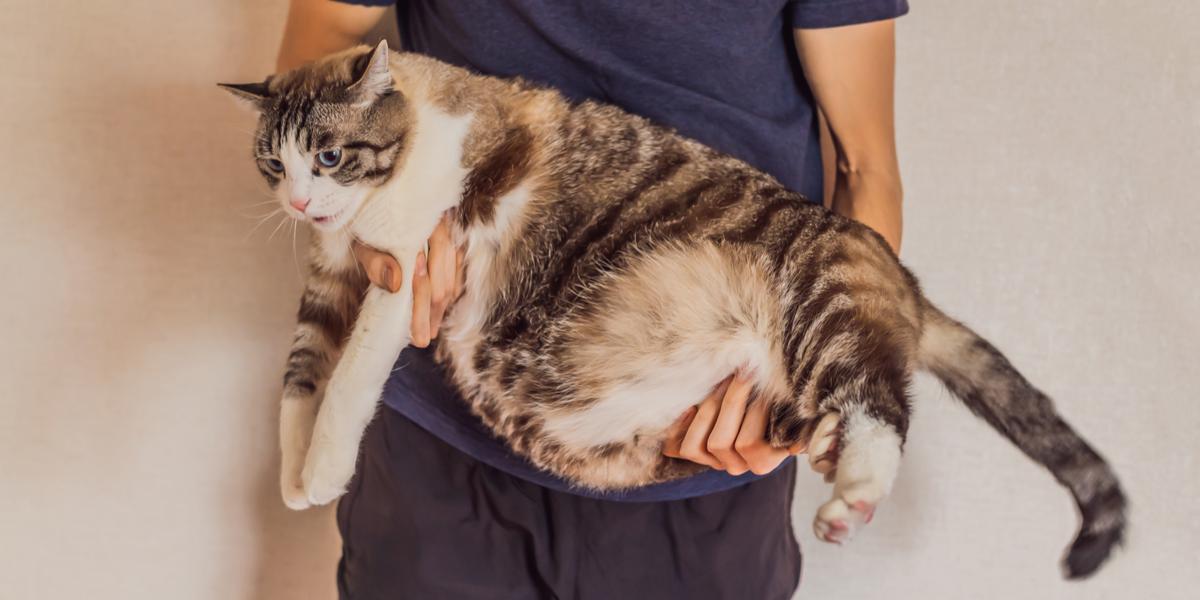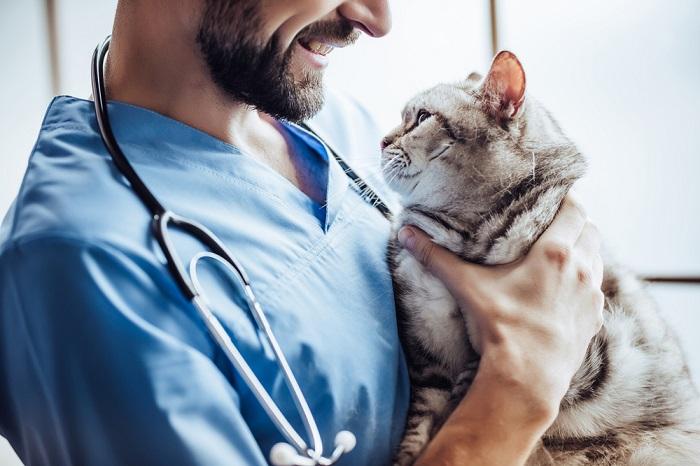
Hip dysplasia is the name given to an abnormally formed hip joint. It is caused by a combination of genetics and environmental factors. Although uncommon in most cats, some pure breeds (such as Maine Coon cats, Himalayan and Persian breeds) are prone to hip dysplasia. It is also more common in cats that are overweight and obese.
Feline hip dysplasia can be difficult to spot.1 The signs are often very subtle and gradual in onset, and many cats hide them well. But hip dysplasia eventually results in hip osteoarthritis, which is painful. Owners of large cats, especially, should be on the lookout for signs of hip dysplasia so affected cats can get a diagnosis and the treatment they need.
What Is Hip Dysplasia?
The hip (coxofemoral) joint is made of a ball (the head of the thigh bone, or femur) and socket (the acetabulum). In a normal cat, the ball sits nicely within the socket, and rotates freely as the cat moves, runs, and leaps about.
In cats with hip dysplasia, the ball and socket don’t quite line up (known as subluxation). The hip joint is loose and does not move as smoothly as it should. Over time, the laxity (looseness) and abnormal movement causes excessive wear and tear and degeneration, and the hip joint becomes damaged and inflamed.
In most cats, hip dysplasia is uncommon. However, the incidence of hip dysplasia in purebred cats can be as high as 24%, with Himalayan, Persian, and Maine Coon cats being particularly prone.2,3 This may result from their smaller gene pool, their larger body size, or a combination of the two.
Hip dysplasia is also commonly seen alongside patella luxation or dislocation (a condition in which the kneecap slides in and out of place)4 and is more common in cats that are overweight or obese.
Signs of Hip Dysplasia
Some cats show signs of hip dysplasia at an early age (as young as 3 to 4 months), whereas many cases of hip dysplasia are not detected until later in life when the cat develops secondary osteoarthritis.
The clinical signs of hip dysplasia can be difficult for cat owners to spot. The signs are subtle and gradual in onset, and cats are very good at hiding signs of pain or joint degeneration.5 Because hip dysplasia often affects both hips, obvious signs of discomfort, such as lameness (limping) are uncommon.
Other signs of orthopedic issues and joint disease in cats include:
- Changes in posture (e.g., crouching)
- Reduced activity
- Abnormal or stiff movement of the hind limbs
- Difficulty getting comfortable
- Reluctance to jump or climb stairs
- Increased falling (e.g. when jumping or walking at height)
- Difficulty crouching or squatting when toileting
More general, non-specific signs a cat is in pain include:
- Changes in behavior (aggression, withdrawal, avoidance, restlessness, irritability)
- Reluctance to be handled or touched
- Weight loss, reduced appetite
- Depression, lethargy
- Inappropriate toileting outside of the litter tray
- Coat changes, reduced grooming
- Increased vocalization
If your cat is showing any of these signs, take them to see your vet.
Diagnosis
Your vet might suspect hip dysplasia based on your cat’s breed and the information you give, but there are several things they need to do before reaching a diagnosis.
They might want to watch how your cat moves and walks. However, many cats will hide their discomfort when in the consulting room, so it is a good idea to record any abnormal movements at home and take videos with you to show the vet.
The vet will need to examine your cat. Examination of the bones and joints in a cat can be difficulty compared with dogs, but the vet will be looking for the following:
- Signs of pain
- Crepitus (cracking/popping) of the joint
- Swelling around the joint
- Loss of muscle mass
- Changes in movement of the hip joints (stiffness or excessive movement)
They will need to take x-rays to look at the hips, and other joints too (often including the spine). Radiographic changes include malformation (partial dislocation), inflammation, and degeneration of the hip joint.
Your cat will need to have a sedation or general anesthesia for the x-rays to be carried out. In some instances, your vet might suggest additional imaging such as an MRI scan.
Treatment Options

Treating feline hip dysplasia is focused on management and easing symptoms as there is no cure.
Feline hip dysplasia cannot be cured but there are things that can be done to keep your cat comfortable and allow them to lead an active, normal life. In most instances, affected cats are managed non-surgically.
Non-Surgical Treatment
The mainstay of non-surgical treatment is pain relief. Cats will be given medications to reduce the discomfort and inflammation caused by hip dysplasia and osteoarthritis.
These medications are not without side effects. Over time, they can start to affect liver and kidney function. In older cats especially, it is therefore important to rule out any underlying health conditions.
Your vet will therefore suggest carrying out a blood test and urinalysis prior to starting long-term treatment. Their liver and kidney function, and maybe their blood pressure, will need to be re-checked once or twice a year.
Small changes to your cat’s environment can go a long way in reducing pain and helping your cat to live a normal life. Things you can do to help include:
- Providing stepped access to raised areas and furniture such as cat flaps, beds, sofas, and window ledges
- Ensuring their food and water are easily accessible
- Providing litter trays with low edges to make it easy for them to climb in and out
Encouraging regular, gentle exercise can also help to maintain muscle fitness, reduce stiffness and prevent obesity (which is bad for their joints). You can do this by:
- Hiding their food in a puzzle feeder or food parcels to encourage foraging, hunting, and predatory behavior
- Providing toys and catnip
- Playing with your cat with feather toys or laser pointers
- Accompanying them on regular, small walks around the house or garden
There is a growing body of evidence of the effectiveness of physiotherapy for dogs affected by hip dysplasia, with reported benefits including improved range of motion, flexibility and muscle strength, and reduced pain.
There are no studies proving it to be effective in cats. The same is true of other physical therapies, such as massage and hot/cold therapy. Always consult your veterinarian before taking your cat for any physical therapy and be sure to see someone who is qualified and has the relevant expertise.
Dietary management to prevent obesity is very important in cats with hip dysplasia, and weight loss can help to relieve discomfort in cats that are overweight. There is evidence that feeding a diet rich in omega-3 fatty acids might provide relief from osteoarthritis, too.6
In humans and dogs, many people recommend the use of supplements such as glucosamine, chondroitin, and green-lipped mussel. Though there is no evidence for effectiveness in cats, it is unlikely that it will do any harm. Speak to your veterinarian about doing a nutraceutical trial.
Surgical Treatment
Surgery is usually reserved for severely affected cases and those for whom non-surgical management is no longer effective. Surgical options include:
1. Femoral Head And Neck Excision (FHNE) Or Osteotomy (FHNO)
This aims to remove the pain associated with abnormal movement of the ball-and-socket joint. The top of the femur (ball) is removed, and the socket remains empty. Scar tissue forms, creating a false joint. Outcomes can be unpredictable.
2. Total Hip Replacement (THR)
This is generally the preferred option. It aims to restore normal function by replacing the joint with a prosthetic hip. It is the more expensive option.
Both the above are major surgical procedures and are not without risk of complication. Neither guarantees your cat will return to normal, and there are significant cost implications for both. It is therefore very important that you discuss all the options with your veterinarian.
Prevention

If your vet suspects hip dysplasia, x-rays taken while your cat is under sedation can confirm the diagnosis.
Make sure your cat is not overweight, as this can increase the amount of wear and tear on your cat’s joints. Encourage regular, gentle exercise to help promote flexibility and strength.
The only other way to prevent hip dysplasia, is for cat breeders not to breed from cats that have it or are prone to it. 7 Sadly, there is no genetic test. However, x-rays taken of the hip joint can determine whether a cat has hip dysplasia and is recommended in at-risk breeds prior to breeding. Scientists also caution against using breed standards that actively encourage large-bodied cats.
Frequently Asked Questions
Can a cat live with hip dysplasia?
Yes, feline hip dysplasia is a chronic condition that cats can live with long-term. It cannot be cured but can be managed. Early diagnosis and treatment are key to helping cats live a normal, and comfortable life.
What can be done for a cat with hip dysplasia?
Cats with hip dysplasia require a combination of pain relief and environmental modification to help manage their condition. Dietary management and supplements may also help. If this is no longer successful, your vet might suggest surgical treatment.
How can I tell if my cat has hip dysplasia?
Feline hip dysplasia can be challenging to spot. Screening for hip dysplasia malformation can be done using x-rays and is recommended in at-risk breeds prior to breeding.
Look out for signs of pain and discomfort in your cat. If you think they might be affected by hip dysplasia, take them to see a vet.
Is hip dysplasia in cats painful?
Over time, the increased laxity and abnormal movement of the hip joint, causes wear and tear and inflammation, and hip osteoarthritis develops. Hip osteoarthritis is a painful condition and needs veterinary treatment.
-
Perry K. Feline hip dysplasia: A challenge to recognise and treat. J Feline Med Surg. 2016 Mar;18(3):203-18. Doi: 10.1177/1098612X16631227. PMID: 26936493.
-
Loder RT, Todhunter RJ. Demographics of hip dysplasia in the Maine Coon cat. J Feline Med Surg. 2018 Apr;20(4):302-307. Doi: 10.1177/1098612X17705554. Epub 2017 Apr 21. PMID: 28430011.
-
Keller GG, Reed AL, Lattimer JC, Corley EA. Hip dysplasia: a feline population study. Vet Radiol Ultrasound. 1999 Sep-Oct;40(5):460-4. Doi: 10.1111/j.1740-8261.1999.tb00375.x. PMID: 10528838.
-
Smith, GK, Langenbach, A, Green, PA. Evaluation of the association between medial patellar luxation and hip dysplasia in cats. J Am Vet Med Assoc 1999; 215: 40–45
-
Lascelles BD, Sheilah AR. DJD-Associated Pain in Cats: What Can We Do to Promote Patient Comfort? Journal of Feline Medicine and Surgery. 2010;12(3):200-212. Doi:10.1016/j.jfms.2010.01.003
-
Mehler SJ, May LR, King C, Harris WS, Shah Z. A prospective, randomized, double blind, placebo-controlled evaluation of the effects of eicosapentaenoic acid and docosahexaenoic acid on the clinical signs and erythrocyte membrane polyunsaturated fatty acid concentrations in dogs with osteoarthritis. Prostaglandins Leukot Essent Fatty Acids. 2016 Jun;109:1-7. doi: 10.1016/j.plefa.2016.03.015. Epub 2016 Mar 30. PMID: 27269707.
-
Low, M., Eksell, P., Högström, K. et al.Demography, heritability and genetic correlation of feline hip dysplasia and response to selection in a health screening programme. Sci Rep 9, 17164 (2019).








We are working on future Hip Displaysia (per our vet.)